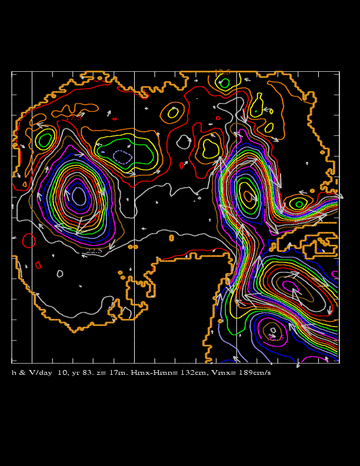| Guide for the DieCAST Ocean Model |
Multiple-Grid Mediterranean Sea/North Atlantic (MEDINA) model simulation
Dietrich, D. E., Tseng, Y. H., Medina, R., Liste, M., Olabarriet, M. Piacsek, S. A., Bowman, M. J. and Mehra, A. (2008), 'Accurate Mediterranean overflow water (MOW) simulation using a coupled multiple-grid Mediterranean Sea/North Atlantic Ocean model on a PC',Journal of Geophysical Research-Ocean, 113, C07027, doi:10.1029/2006JC003914, 2008. Model descriptionSimulation DomainThe six grids are shown; including a Strait of Gibraltar region with 1/24 degree resolution.
Animation from the westernmost grid of the six grid MEDINA model [high resolution MPEG format] surface height contour and velocity vector within a 320 days sequence during model year 4
CARIBBEAN SEANote the westward propagating of anticyclonic eddies in Caribbean Sea and semi-permanent cyclonic gyre in southwestern Caribbean Sea. GULF STREAMDuring first 60 days, two strong cyclonic frontal eddies spin off the Cape Hatteras abutment and into the New York Bight. Typically about 10 warm- and cold- core rings exist near the Gulf Stream. Around day 88, an intense warm core ring pinches off a northward Gulf Stream meander. It is reabsorbed into the Gulf Stream around day 110.GULF OF MEXICOAround day 50 a cyclonic recirculation eddy spins off the Cozumel abutment into the Gulf of Mexico along the Loop Current front. It deforms the Loop
Current front, resulting in a small warm-core eddy separation around day 100. The warm core eddy is reabsorbed into the Loop Current around day 125.
At day 125, we zoom to the Gulf of Mexico to show the strong eddy field in the northeastern Gulf of Mexico. This eddy field is energized by
frontal eddies separating and taking energy away from the Loop Current. The nonlinear eddy field absorbs and disperses the energy.
A strong cyclonic Dry Tortuga eddy results from Loop Current frontal vorticity accumulation around day 140. As it knifes westward, a major
warm core eddy is nearly separated. However, the warm core eddy reattaches before an intense cyclonic wake recirculation eddy spins off the Cozumel
abutment causes a full separation.
Intense nonlinear eddies lead to a sharp right angle turn of the reformed Loop Current into the Florida Strait.
MESOSCALE EDDIES AND RED TIDESThe modeled frontal and shelfbreak eddies affect the coastal environment. They lead to cross-shelfbreak spurts that ventillate the coastal regions with deep Gulf of Mexico near-surface water. They may be crucial to modeling and understanding Harmful Algal Blooms and disastrous red tide events. ZOOM OUT AT DAY 246 TO THE FULL WESTERNMOST GRID OF THE MEDINA MODELThis day 246 snapshot shows the formation of a major warm core ring and an intense Cape Hatteras cyclonic wake recirculation eddy. ZOOM INTO THE GRAND BANKS REGIONThe continuing animation zooms into the Grand Banks region to clearly show very nonlinear Gulf Stream dynamics. This includes shelfbreak warm core rings that sometimes lead to a "Loop Current" feature carrying warm Gulf Stream water into the Gulf of Maine. The Gulf of Maine bathymetry effects are clear. This is noteworthy, because they were realistically modeled by a full Mediterranean Sea, Caribbean Sea, Gulf of Mexico and North Atlantic Ocean model running on a personal computer. |


